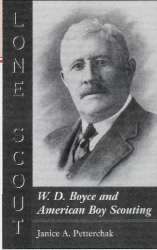 |
Home | Search | Browse | About IPO | Staff | Links |
 |
Home | Search | Browse | About IPO | Staff | Links |

The godfather of scouting Lone Scout: W. D. Boyce and American Boy Scouting San Simeon, California, had William Randolph Hearst but Ottawa, Illinois, had William Dickson Boyce. Both men had a profound influence on literacy and the publishing industry in America, but only Boyce could boast of having founded the Boy Scouts of America. To his credit he didn't, and that is reason enough for this book. In Lone Scout: W.D. Boyce and American Boy Scouting, Janice Petterchak serves up an engaging biography of Boyce, a two-dimensional portrait of one Illinois' more remarkable philanthropic industrialists. Boyce (1858-1929) was a complex character and Petterchak sketches him head on, balancing his shadowy compulsions with the compassions of an ardent social reformer. What we end up with is a fairly sympathetic image of Boyce drawn from the plentiful facts and details of his very public life. What we don't get is what made him tick. Boyce was a self-made man, a textbook model from the Horatio Alger school. As another Boyce biographer put it, "He had a first-rate brain, a buoyant extrovert personality, and above all was endowed with that rare talent of knowing how to make money." That Boyce found employment for all these qualities and profited from them attest to his ardor and ambition. Born on a farm in Pennsylvania, Boyce learned early the value of education, and was teaching others in a local school by the time he was sixteen. He attended college for two years, then left for the Dakotas, where he bought a newspaper, the Dakota Star, and put his "shoulder to the wheel." By the mid 1880s, Boyce had a wife and family and was living in Ravenswood just north of Chicago, working with Chicago printer Richard Donnelley. In 1887, Boyce and several investors founded the Saturday Blade, a weekly family newspaper that would become the foundation of his sizable fortune in later years. Five years later the Blade had "the largest circulation of any newspaper in the country," which gave Boyce the capital he needed to become an entrepreneur and industrialist. In 1903, he moved his family to Ottawa, not far from Marseilles, where on rapids of the Illinois River he built a paper mill to supply his, and others, newspapers. In short order he became owner of the Marseilles Land and Water Company, and he purchased his San Simeon, a palatial mansion described as "the finest residence in the state outside to Chicago," a four story house with sixteen bedrooms, fifteen fireplaces, a freight elevator, eleven cathedral windows, and "the finest and most costly furniture and furnishings." Meanwhile, the money rolled in. Part of Boyce's master plan involved the use of a hitherto unused workforce: adolescent boys, who, Boyce reasoned, could sell his newspapers and likewise learn to be businessmen, albeit on a much smaller scale. Boyce championed his workforce, and when he found an opportunity to give back to them, he made it his mission. The opportunity came in 1909, when Boyce was in England buying supplies for an African safari. According to the story, later immortalized in a Norman Rockwell painting, Boyce was guided through a thick, London fog by an English Boy Scout, who refused a reward for his "good deed." Boyce was so taken by the Scout's bearing and code of honor that he thought them worth importing to America. On his way home from Africa, Boyce met Lord Robert Stephenson Baden-Powell, founder of the Boys Scouts of England, and discussed the feasibility of licensing the organization in America. In 1910, the Boys Scouts of America was chartered. Boyce's many contributions to that organization, as well as his role in the founding of the "Lone Scouts," a scouting organization for boys in rural areas, are well documented in Petterchak's narrative. But in the end, Boyce is far too big for Petterchak's 152-page treatment. His excesses, prejudices, overt racism, sexism—all dismissed as the prerogatives of the wealthy and the byproducts of Progressivism— demand, if not accountability, at least some analysis. Why did Boyce, who on paper insisted that blacks not be excluded from his scouting programs, consider the white race superior to all others? Why, when his first wife and daughters were such able outdoors-women, did he exclude girls from his scouting programs? Was his motivation for using unsalaried adolescent labor to distribute his very profitable publications entirely benevolent? Did he do a good deed every day, or just expect one from his employees? These and other questions remain unanswered in Lone Scout. Nevertheless, the portrait Petterchak gives us of Boyce is compelling, honest, and memorable. Too bad she stopped short of pinning the tail on the donkey. 29/IILLINOIS Heritage |
|
|